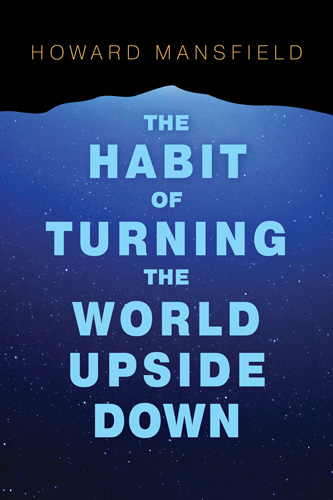The Habit of Turning the World Upside Down
Howard Mansfield’s new book, The Habit of Turning the World Upside Down, is a series of essays describing public and private projects that have deprived people of ownership. Entities behind the projects often claim they’re “acting in the public interest,” writes Mansfield. He goes on to say, “I was especially interested in the emotional toll these projects took. [ . . . ] I was witnessing an essential American experience: the world turned upside down. And it all turned on one word: property.”
Howard Mansfield’s new book, The Habit of Turning the World Upside Down, is a series of essays describing public and private projects that have deprived people of ownership. Entities behind the projects often claim they’re “acting in the public interest,” writes Mansfield. He goes on to say, “I was especially interested in the emotional toll these projects took. [ . . . ] I was witnessing an essential American experience: the world turned upside down. And it all turned on one word: property.”
Mansfield livens up what, in less expert hands, could have been dry reading of a narrowly defined subject. He avoids this by presenting courageous individuals who endure menacing abuse as they struggle to hold onto their property. One particularly moving story is that of Romaine Tenney, a Vermont farmer whose land had been in his family since 1892. We learn: “He was a happy man—until his farm was destroyed to build Interstate 91.”
Eminent domain gives the government “power to take private property for public use without the owner’s consent,” explains Mansfield. “The Constitution says the owner must receive ‘just compensation’ [ . . . ]” Tenney was twice offered compensation for his land and twice refused, saying the only time he’d left his land was to serve in the military. One day after he was served with a court order, writes Mansfield, Tenney “barricaded himself in the house and set it on fire.” A rifle was found in the rubble of his home.
Mansfield doesn’t ignore lands grabbed from Native Americans, and he devotes a good deal of copy to several past events, though it’s obviously a violation that’s ongoing. He spent time with the Tohono O’odham tribe in Arizona’s Sonoran Desert. A couple of telling sentences from his experiences:
The native peoples I have known, Onondagans and Abenaki among them, were plagued by the good intentions of white folks who thought that they, too, were some part native, some part Cherokee, or who hung up Dream Catchers around their house and believed that they could add the ways of the Lakota Sioux to their New Age collection.
Even more disturbing: “The natives I knew were also plagued by disbelief, by whites who thought that all the real Indians were dead, gone with the buffalo.”
And as for America’s first president, Mansfield doesn’t let George Washington off the hook, writing that, among other actions, “[Washington] worked in secret to buy land in Ohio beyond a line that forbid purchase.”
In the essay about New Hampshire’s White Mountains, we learn about the damage that’s dealt to the land itself—not just the people living there: “The lumber companies clear-cut the mountains, [ . . . ] barren mountainsides slid into rivers; the slash caught fire.” Mansfield adds that “Before the logging era, fires were rare.”
He writes about an early conservation organization to protect those New Hampshire mountain forests. Eight men and one woman campaigned for ten years to reach their goal. Now, if I have one criticism with this volume, it’s that we never learn the name of that one woman. Wouldn’t her story have been an interesting addition to this effort?
That aside, opposition to eminent domain is not an easy path to take. “If you are happy planting dahlias and mowing your lawn, you may find yourself having to justify why your pursuit of happiness should stay a big public or private project,” writes Mansfield.
But in the case of the Kinder Morgan energy infrastructure company and their plan to build a natural gas pipeline across New York and Massachusetts, Vince and Denene Premus fought and did prevail.
Their ordeal began in January 2014. As Mansfield describes, “It seemed unreal to Vince and Denene. How could some Texas company lay claim to their land, and as they saw it, threaten their safety?” The company already had a history of serious accidents including fires and explosions. Others joined with the couple in writing letters and holding marches. Then on April 20, 2016, Kinder Morgan announced the pipeline project was suspended. But unfortunately, the story doesn’t end there.
Mansfield makes an interesting point, timely when the idea of boundaries and borders are on our minds, when he writes:
There are many clever definitions of property but they all share this characteristic: exclusion. [ . . . ] Each boundary severs what was once whole. Each line drawn across the land reorders the world and buries history.
He also issues a warning against public indifference:
All of us can end up in the crosshairs of some surveyor, some big project in the public interest, our house sliced in two by the dotted line on someone’s plan. Romaine may belong more to our future than our past. There are more of us and we’re in the way of ever-bigger projects.
Keeping our own participation in mind, do pay attention to the stories of individuals courageously fighting in The Habit of Turning the World Upside Down.





